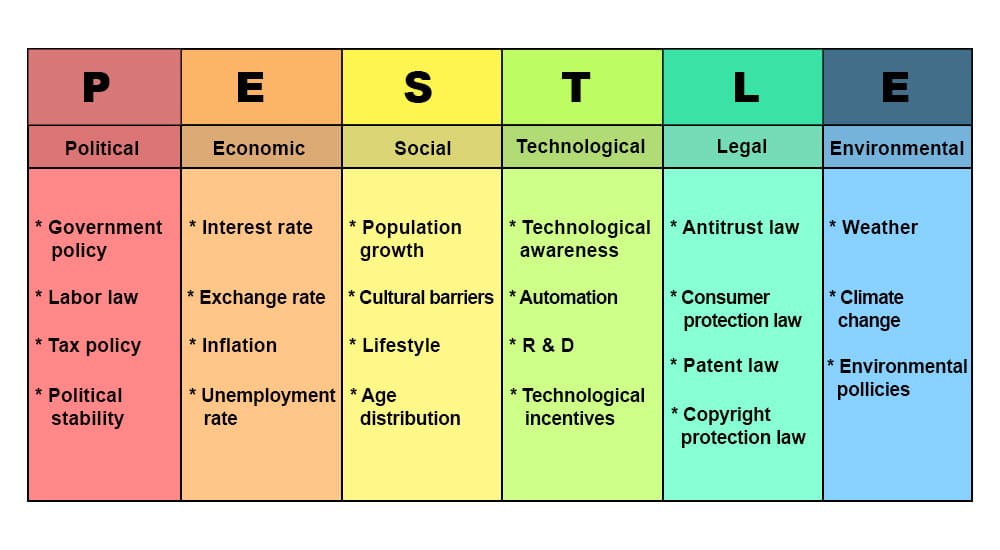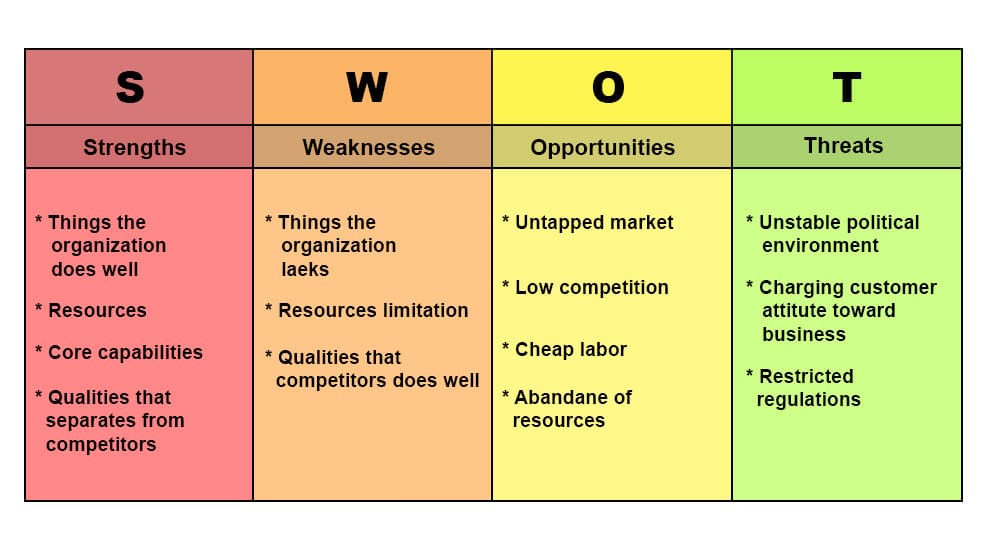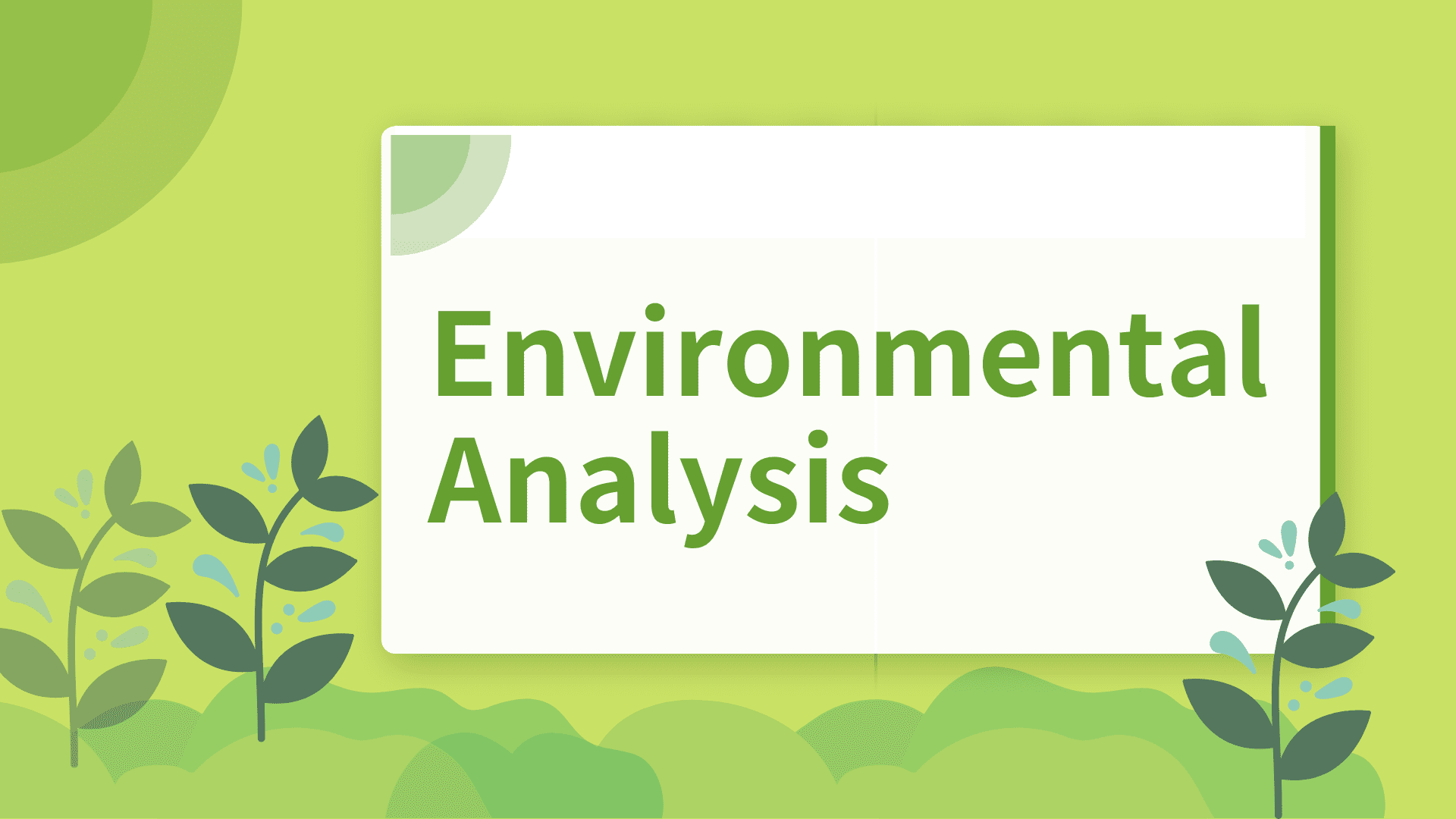A business environment refers to all the external and internal factors that affect its operation. It comprises economic, social, political, financial, and institutional elements.
Environmental analysis helps a business identify its strengths, weaknesses, threats, and opportunities so organizations can operate efficiently.
What Is Environmental Analysis?
Environmental analysis refers to the study of external factors that impact a business. In this analysis, analysts study the economic conditions, financial position, political landscape, technical advancements, etc.
Companies develop strategies after studying external factors. This improves business performance and optimizes operations. Analysts examine external factors, identify issues, and derive solutions.
Environmental Analysis Techniques
1- PESTLE
PESTLE analysis is the study of macroeconomic factors that impact a business. It helps enterprises make decisions after analyzing the external environment. Through PESTLE analysis, businesses can understand the overall industry sentiment. It provides future predictions about where the business is headed.
It consists of six elements:
- Political factors that analyze a country’s political environment. It studies international relations, geopolitics, national and international politics. This helps the business understand how the country’s political environment can affect the business. Government policies and regulations are also studied in this analysis.
- Economic factors study the economy. It provides businesses with information about where the economy is leading. It explores economic factors like GDP, unemployment, and the forex rate. A positive economic condition is beneficial for business operations.
- Social factors such as values, people’s mindsets, norms, and traditions impact the business. The business’s sales, revenue, and income depend on human beings. Hence, social factors directly impact them. This includes wealth distribution, lifestyle, gender, and more.
- Technological factors refer to the advancement of industry or country. Advanced technology positively affects a business. The environmental analysis investigates discoveries, innovative technologies, etc., and increases operational efficiency.
- Legal factors such as regulations change over time. A business is impacted by the laws put in place by the government. If not, they can be sanctioned for violating the rules. Unfortunately, as regulations are stricter, the business process is weakened and slowed down.
- Environmental factors like weather, climate, location, and waste disposal impact all businesses. How companies use a certain resource or product defines the implications of environmental analysis.

2- SWOT
SWOT analysis helps businesses understand their strengths, weaknesses, opportunities, and threats. These factors help understand where the business stands and where it is headed. It provides the analysts with a framework for what needs to be done next.
It consists of two elements:
- Internal factors, aka strengths and weaknesses, are influenced by the business and can control these factors. A business’s strength can be the brand name or a lack of substitute products. A weakness can be inadequate product development. Both these factors are caused internally.
- External factors, aka opportunities and threats, are outside of the business influence. The business has no control over them, and the factors occur independently. For example, a business threat is the presence of several competitors. An opportunity can be a drop in tariffs for import/export. Hence, the business has no control over the factors but is impacted by them.

Benefits of Environmental Analysis
1- Helps in Forecasting
Environmental analysis helps businesses understand where they stand and where they can be. This helps in forecasting future trends and market conditions. By doing this, businesses can make decisions that benefit them in the long term.
2- Enables Achieving Business Objectives
When a business adjusts its strategies based on environmental analysis, it moves closer to success. They can attain their goals by formulating strategies based on the analysis.
3- Makes Business Aware of the Market
With environmental analysis, businesses are in constant touch with the market. This helps businesses understand what is happening in the industry, allowing them to react and adjust to market demands and achieve corporate objectives. Additionally, businesses change their stages based on market requirements.
4- Anticipate Opportunities and Threats
The environmental analysis makes organizations aware of business opportunities and threats. Companies can then respond to the opportunities and manage threats. This helps the firms gain a competitive advantage in the market.
5- Understand the Causes of Disequilibrium
With the fast-changing environment and dynamic industry, a business can witness disequilibrium. Environmental analysis helps firms to identify the reasons behind this disequilibrium. Thereof, analysts can devise solutions to bring the business back into equilibrium.
Limitations of Environmental Analysis
1- Does Not Warn Against Unforeseen Events
The environmental analysis does not warn businesses against unforeseen or adverse events. It does help businesses forecast future trends. However, it does not help eliminate the uncertainty. Through this analysis, businesses cannot avoid unexpected events that occur during analysis. Though, it does decrease the frequency of such shocks to occur.
2- Does Not Follow a Strategic Approach
Businesses can build strategies based on environmental analysis. However, the analysis itself does not follow a strategic risk-taking approach. This means it leads the businesses to operate cautiously and has no rigid strategy.
3- Not Independently Reliable
The environmental analysis provides businesses with solutions but is not independently reliable. This means that businesses must conduct other analyses as well to confirm solutions. If an analyst only decides based on environmental analysis, it may or may not work in the business’s favor. However, when an environmental analysis is combined with other strategic approaches and analyses, the results are more reliable.
4- Does Not Guarantee Effectiveness
Environmental analysis is conducted to improve business effectiveness and operations. However, it does not guarantee the same. The analysis acts as an input in the strategy to develop an output. Hence, it is not advised to trust a single study to build organizational effectiveness critically. The data’s verifiability and accuracy must be confirmed to ensure ideal outcomes. If the data is not accurate, reliable, and verified, it may lead businesses to make wrong decisions.
5- Creates Confusion
The environmental analysis focuses on too much business information at once. It considers both the advantages and disadvantages of a business. This may lead to confusion amongst analysts. The more information on hand, the more challenging to derive a solution. Hence, the abundance of information acts as a hindrance to solving issues.
Steps To Conduct Environmental Analysis
1. Identify Factors
The first step in conducting an environmental analysis is to select the factors needing evaluation. These factors can be legal, social, technical, economical, or more. The factors for analysis depend on the industry the business belongs to. For example, an IT business focuses more on technical aspects. A healthcare business would want to analyze its legal factors. When analysts select the factors they plan to anatomize; they ensure the ones impacting the business are chosen.
2. Critically Examine the Factors
After choosing the factors, analysts examine them. Information is collected related to all these factors. Analysts research and observe the factors. They can either collect information verbally or in writing.
Verbal information is collected through observation and note-taking. In contrast, written information is collected by reading and examining. Analysts can use online resources or read print magazines, journals, and books to research what will impact the business.
3. Scan Competitors
Analysts then scan the competitors and evaluate their position in the industry. This helps them determine threats and opportunities for the business. Analysts collect information about competitors in traditional or nontraditional ways.
The traditional way of collecting information is through primary or secondary sources. A non-traditional way of collecting information is through spying. They learn the new events with competitors, so they implement the same in their businesses. Businesses also learn from other business mistakes and avoid them. This helps in increasing business effectiveness and efficiency.
4. Evaluate Organizational Impacts
Once analysts know what other rival firms are doing, it is time to evaluate organizational impacts. This is done through forecasting. With forecasting, they can predict how certain factors impact a business. This helps in identifying threats, opportunities, weaknesses, and strengths.
Analysts use brainstorming, surveying, and more to forecast the impact. Forecasting can also be done based on competitors and how they may impact the business. Decisions are taken based on such impacts for the betterment of the business.
5. Devise A Plan
After evaluating organizational impacts, analysts devise a plan after surveying all environmental factors. The plan consists of problem statements and solutions focusing on bettering business operations and productivity. Through this plan, businesses can achieve their core objectives.
6. Implement the Strategy
After the analysts devise the plan, it is finally time to implement the strategy. The plan consists of solutions that the business must use to enhance efficiency. These solutions are factor-driven, meaning there is a specific solution for each problem concerning a particular factor. Once the strategy is implemented, businesses can use the opportunities and avoid threats.
Example of an Environmental Analysis
Consider Mr. X an analyst at ABC Pvt. Ltd., a financial services firm. The recent developments in the financial industry lead Mr. X to conduct an environmental analysis. Since technological advancements drive the financial sector, Mr. X decides to do a PESTLE analysis.
In this analysis, Mr. X considers the political, economic, social, technological, legal, and environmental aspects. However, he focuses on the technical aspects more. He compares the technological advancements happening in other companies in the same industry.
The results show the emerging technical sound service advancements. It shares that robust chatbots in financial services help increase business profitability. Since ABC Pvt. Ltd. does not have a powerful chatbot yet, Mr. X decides to build one. The solution from the analysis states that strengthening their after-sales services through technical advancements is needed. Once that is done, the business witnesses a 15% jump in revenue and profitability. Hence, the analysis is deemed successful.
Final Words
Environmental analysis helps organizations understand internal and external factors affecting the business. The strategic tool successfully assesses all factors affecting the business. It identifies problems and what needs to be done to solve them. This results in attaining business objectives.
The environmental analysis process is lengthy and requires much time. However, the solution derived from the process improves organizational performance. Businesses can benefit from efficient strategies that help in enhancing operations. This results in increased revenue and business profitability.

This is because acknowledgement.